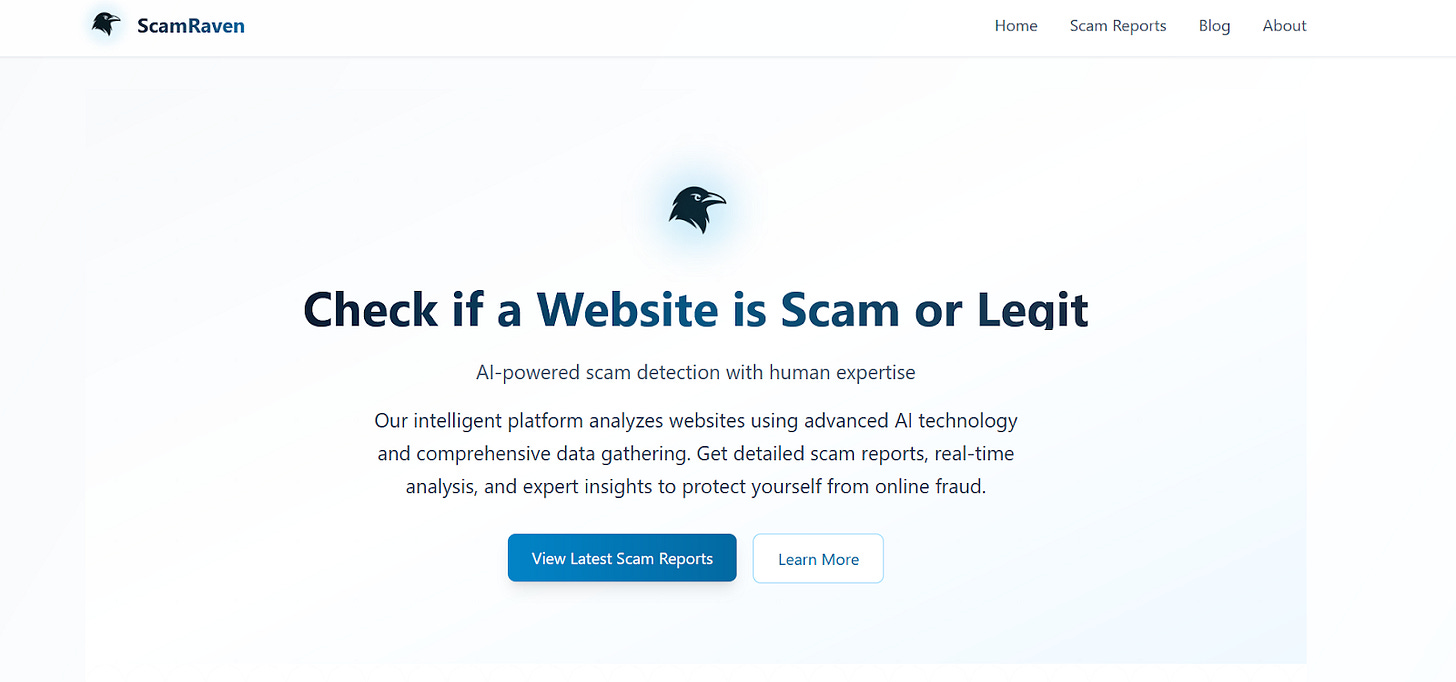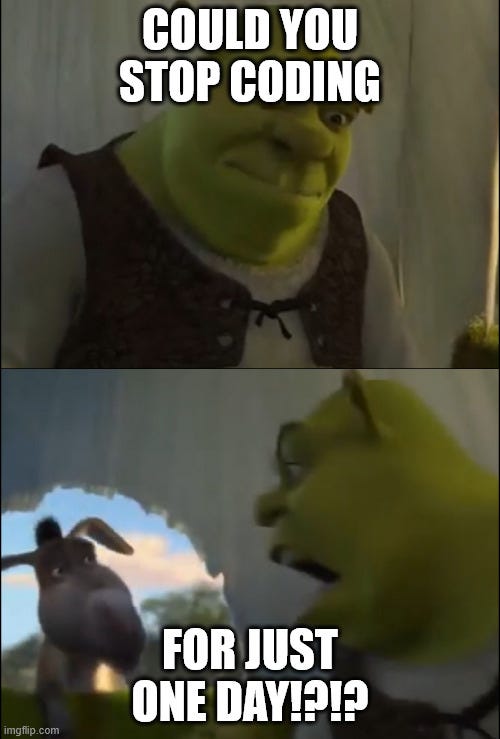New Project: Building a Scam Website Checker: Update 1
Kicking off ScamRaven: an experiment in AI-powered scam site detection, SEO, and side-project building
Looking for a side project idea, I came up with a problem:
Too many websites look suspicious but aren’t clearly scams. Some are shady shops, some just feel “off,” and others are straight fraud.
Existing solutions like Trustpilot and ScamAdvisor don’t really solve this. They either rely too much on crowdsourced reviews or surface shallow trust scores without much real analysis.
They do this by mass-scanning the internet. Yes, they have proprietary scoring technology, but from what I’ve seen, it doesn’t do wonders.
My idea is to do it differently. To do it better. And to use AI to make it scalable. I won’t be competing on quantity - realistically, this will be a business of collecting breadcrumbs left behind by the big names.
But this fits into another goal of mine: testing how content sites perform with AI. I’ve built Amazon affiliate sites before the AI boom, but publishing has shifted. I want to see if using AI still gives any chance of success.
This intro post will be a bit longer (even though I summarized it already), so please bear with me.
TL;DR:
I'm launching ScamRaven, a project to use AI and curated data to check if websites are scams.
The Idea: Generate in-depth scam reports on suspicious websites, combining automated scanning with AI-powered analysis.
The Goal: Build a collection of high-quality scam reports to help users and test if AI-generated content can still rank in 2025.
The Future: Validate the concept, and potentially monetize through ads or scam-checking tools.
The Core
With my background in cybersecurity - having seen countless phishing campaigns and shady sites - I know how to identify them. That gives me a perspective many review sites lack.
Here’s how I imagine the project working:
Develop a scanner to check basic info (WHOIS, TLS, blacklists, etc.), scrape the site, identify its niche, and run niche-specific checks (to be figured out).
Feed everything into AI, ask it to do its own research, but use my input as the source of truth.
Generate a scam report based on a structured template.
After that, I’ll review the results manually - because hallucinations are real.
The end product: content for my website targeting long-tail keywords like “Is X website legitimate or a scam?”
The plan is to start with a batch of manually reviewed reports, publish them regularly, and then let SEO work in the background. I expect it will take at least six months before I know if the experiment is working.
My long-term goal: offer free scam-checking tools, which would both help users and boost the site.
Monetisation
Potential revenue streams include:
Ads (if traffic grows large enough)
Affiliate deals with digital products related to scams/cybersecurity
My consulting services
Longer-term: offering the scanning “core” as a service via API
For now though, monetisation is far off. The first step is proving the concept.
Why the Scam Sites Niche?
In my review of website investments after 3 years, I came across findlegit.com, which publishes scam/legitimacy checks on websites.
Initially, I thought it was a terrible niche: manually written posts about random sites, competing against giants like Trustpilot and ScamAdviser, who attracts millions of monthly visitors.
But the idea stuck with me. What if I built something actually effective?
Coming Up with ScamRaven
I’ve spent far too much time naming past projects. This time I just went with my first idea: ScamFrog.
Frogs catch flies.
ScamFrog would catch scams. Smart, right?
But then I remembered the SEO tool Screaming Frog. It’s trademarked, and since I’d also be doing website analysis, this felt risky legally. While it might not matter at my size, if the project grew or I wanted to sell it, it could become an issue.
So, after sleeping on it, doing some research, and asking ChatGPT’s opinion, I landed on ScamRaven.
In the same chat, I also asked for a logo - here’s what it came up with:
Looks raven-ish enough to me.
So I just removed the background and decided to use it.
Stage I Roadmap
For the first iteration (I am going to call it Stage I), the goal is to validate the niche before investing in heavy tech.
That means:
Building a simple but clean website
Defining a structure for scam reports
Implementing basic checks in code
Summarizing 50 reviews with AI (symbolic number to start with)
Publishing them and waiting for SEO to kick in
This translates into the following action plan:
Analyze competitors – I’ve done an initial review (content volume, free/paid tools, monetisation methods), but I’ll need a deeper dive to reverse-engineer their success.
Define scope – I’ll look at what people are asking online: which industries and websites get questioned the most. Reddit is a great source for this, especially the grey-zone sites people debate.
Define needed context – From TLS certificates to WHOIS data to site content analysis, I have a longlist of ~20 data points that could strengthen the scanner. The challenge is figuring out how AI interprets them.
Start manually – I’d love to automate everything, but first I need to see if manual reports rank before investing time into building the “core.”
Risks of Doing This in Public
I’m exposing a project that barely breathes to the world.
Of course there are risks:
Negative SEO – Competitors or trolls could attack rankings. However, this is manageable if caught early.
Copycats – Someone could clone the idea and put more resources into it. But since my Substack is small, the risk is limited.
Getting hacked – Always a risk, but I know the main attack vectors, and this isn’t a banking app. Recovery would be manageable.
Embarrassment – The biggest one. Building something awkward, or worse, dropping it after announcing publicly. I have to admit that I’ve done it before. It’s hard to shake this feeling of.
But to manage the risks, I will keep some details private:
Keyword research strategy – I’ll focus on long-tail SEO traffic, but won’t share my exact method.
Core scanning logic – I’m experimenting with how to balance data collection and analysis. Revealing too much would make copying easier.
In the future, I may share more in-depth details with paid subscribers.
Progress So Far
Before releasing this post, I wanted to show progress.
Domain – Bought from Porkbun.com. Registered for 3 years to feel commited. I’m planning to write a separate review on Porkbun, but lately I’ve started liking it for hobby projects.
Frontend – Initial version is live. It was “vibe coded with love.”
Frontend isn’t my strength. So I asked Cursor to help.
The result: www.scamraven.com - a clean, responsive site built with React, Next.js, and Tailwind.
It wasn’t one-prompt magic. It took ~4 hours of iterating, tweaking, and refining sections and the whole layout.
I’ve explained what I want to the AI:
Static pages from markdown files - easier formatting.
Responsive design - an important thing for UX and Google (SEO).
Simple styling - I’ve asked to use shadcn (a frontend framework that has many components), but it seems that AI agent ignored this at some point. But I am still happy with the current outcome
I’m happy with the result - it’s simple, scalable, responsive, and ready for ads later.
Hosting – Deployed on Vercel. Static pages mean fast loading speed, which benefits SEO, and Vercel’s free tier is perfect for a hobby project. Setup was easy: GitHub repo → import to Vercel → DNS records → done.
Core Scanner – Early Python scripts are working. They can generate reports that can be later fed into AI.
I promised myself not to over-engineer before there’s real need… but it’s hard to resist coding.
The results look promising, but fact-checking is essential. My PoC shows this is doable, but it’ll take many iterations to get reliable reports.
I expect I’ll still need manual editing, but the long-term goal is to reduce it to light fact-checking.
This Was the Official Kick-Off
It’s live. You can check it on www.scamraven.com. It contains some lorem ipsum, not every page exists yet, but the foundation is there.
This was the easy part. Now comes the real challenge: building the scanner and generating content.
I’ll keep updating this journey. Since I’ve got other topics I want to cover on Substack too, expect updates maybe once a month. Hopefully with interesting progress to share.





